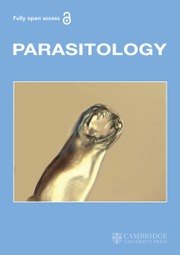No CrossRef data available.
Article contents
An experimental study of East Coast fever in Uganda IV. A study of the East Coast fever reactions produced when infected ticks 171 days old were fed on susceptible calves in limited numbers over a period of 3 weeks
Published online by Cambridge University Press: 06 April 2009
Extract
This experiment showed that infections of Theileria parva were still viable in nymphae of Rhipicephalus appendictdatus 171 days old, but when nine nymphae were fed on calves at intervals over 22 days the reactions produced were most irregular.
In group A reactions varied from acute fatal type to mild, doubtful or no obvious reaction. None of the four animals which survived was protected from subsequent infection when grazed in a tick-infested paddock (Table 1). The two fatal reactions which developed in this paddock varied in intensity; calf no. 5717 showing a typical acute East Coast fever reaction, but the reaction of calf no. 167 showed several atypical features especially in the sporadic appearance of Koch's bodies.
In group B the reactions were again in marked contrast to those seen in group A, one fatal reaction developed and only mild transient reactions without the production of Koch's bodies were seen in the remaining five calves. These mild reactions, however, appeared to be sufficient to protect against subsequent re-infection in the tick-paddock (Table 4).
It is doubtful if the transient reactions seen in calves nos. 5734 (on the 12th day), 172 and 168 could be diagnosed clinically under field conditions, and further investigations as to the infectivity of these types of reactions are required.
In calves nos. 165 and 167 Koch's bodies were absent from all tissue smears at time of death, and diagnosis of the true cause of death by smears alone would therefore be difficult. Reactions such as those given by calves 133 and 139 cast further doubt on the ability to diagnose East Coast fever by gland-smear technique.
In general, the results of this experiment appear to indicate that if the original reaction is mild a second reaction may develop within a few weeks with or without the production of Koch's bodies. The development of a durable resistance to further attacks may not, therefore, depend on the presence of Koch's bodies in the peripheral glandular tissues in detectable numbers.
My thanks are due to the Director of Veterinary Services, Uganda, for his permission to carry out this work and to publish this paper.
- Type
- Research Article
- Information
- Copyright
- Copyright © Cambridge University Press 1951




